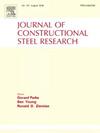A review of experiments on cold-formed steel members at elevated temperatures
IF 4
2区 工程技术
Q1 CONSTRUCTION & BUILDING TECHNOLOGY
引用次数: 0
Abstract
Cold-formed steel assemblies are commonly used for partition walls in buildings, playing a critical role for fire compartmentation, and are also increasingly used as load-bearing structural systems due to their high strength-to-weight ratio and suitability for off-site prefabrication. This evolution leads to a need to characterize the behavior of these systems under the combined action of loading and fire. The objective of this paper is to provide a review of experimental studies on cold-formed steel members and assemblies at elevated temperatures. A comparative overview of testing methods is presented with a focus on the heating and loading procedures, temperature distributions, and end boundary conditions. The review covers experimental tests on lipped channels and built-up sections in compression and flexure, and wall and floor assemblies. The impact of elevated temperature on material properties and member strength is explored. Drawing on data from 30 experimental studies, the review examines the effects of end boundary conditions, section shape, temperature distribution, gypsum sheathing, and internal insulation on the stability and strength of the thin-walled members. Recommendations for future research include member experiments with non-uniform section temperatures and under localized fires, comparisons of steady-state and transient tests, and studies on lipped channel joists. By synthesizing key findings and identifying research gaps, this review aims to guide future experimental studies and support the advancement of building codes and performance-based fire design methods for cold-formed steel structures.
求助全文
约1分钟内获得全文
求助全文
来源期刊

Journal of Constructional Steel Research
工程技术-工程:土木
CiteScore
7.90
自引率
19.50%
发文量
550
审稿时长
46 days
期刊介绍:
The Journal of Constructional Steel Research provides an international forum for the presentation and discussion of the latest developments in structural steel research and their applications. It is aimed not only at researchers but also at those likely to be most affected by research results, i.e. designers and fabricators. Original papers of a high standard dealing with all aspects of steel research including theoretical and experimental research on elements, assemblages, connection and material properties are considered for publication.
 求助内容:
求助内容: 应助结果提醒方式:
应助结果提醒方式:


